Distribution and Abundance of Native Orchids on Roadside Trees in a Global Biodiversity Hotspot
Abstract
1. Introduction
2. Materials and Methods
Study Area
3. Results
4. Discussion
5. Conclusions
Supplementary Materials
Author Contributions
Funding
Acknowledgments
Conflicts of Interest
References
- Krömer, T.; Einzmann, H.J.R.; Mendieta-Leiva, G.; Zotz, G. Impact of Land-Use Change on Vascular Epiphytes: A Review. Plants 2025, 14, 1188. [Google Scholar] [CrossRef] [PubMed]
- Schuiteman, A.; Kailash, B.; Shrestha, U.B. A Checklist of the Orchidaceae of India André Schuiteman, Uttam Babu Shrestha. In Monographs in Systematic Botany from the Missouri Botanical Garden; The University of Chicago Press: Chicago, IL, USA, 2021; pp. 1–264. [Google Scholar]
- Vijayan, D.; Kaechele, H.; Girindran, R.; Chattopadhyay, S.; Lukas, M.C.; Arshad, M. Tropical Forest Conversion and Its Impact on Indigenous Communities Mapping Forest Loss and Shrinking Gathering Grounds in the Western Ghats, India. Land Use Policy 2021, 102, 105133. [Google Scholar] [CrossRef]
- Reddy, C.S.; Jha, C.S.; Dadhwal, V.K. Assessment and Monitoring of Long-Term Forest Cover Changes (1920–2013) in Western Ghats Biodiversity Hotspot. J. Earth Syst. Sci. 2016, 125, 103–114. [Google Scholar] [CrossRef]
- Yokoya, K.; Zettler, L.W.; Kendon, J.P.; Bidartondo, M.I.; Stice, A.L.; Skarha, S.; Corey, L.L.; Knight, A.C.; Sarasan, V. Preliminary Findings on Identification of Mycorrhizal Fungi from Diverse Orchids in the Central Highlands of Madagascar. Mycorrhiza 2015, 25, 611–625. [Google Scholar] [CrossRef]
- Sarasan, V.; MK, R.N.; Venugopal, M.; Sukumaran, P.N. Rescue of Native Orchids and Introduction to an Urban Landscape: Potential Benefits to Supporting Conservation and Connecting People with Nature. Diversity 2025, 17, 184. [Google Scholar] [CrossRef]
- Besi, E.E.; Mustafa, M.; Yong, C.S.Y.; Go, R. Habitat Ecology, Structure Influence Diversity, and Host-Species Associations of Wild Orchids in Undisturbed and Disturbed Forests in Peninsular Malaysia. Forests 2023, 14, 544. [Google Scholar] [CrossRef]
- Turner, I.M.; Tan, H.T.W.; Wee, Y.C.; Bin Ibrahim, A.; Chew, P.T.; Corlett, R.T. A Study of Plant Species Extinction in Singapore: Lessons for the Conservation of Tropical Biodiversity. Conserv. Biol. 1994, 8, 705–712. [Google Scholar] [CrossRef]
- Myers, N.; Mittermeier, R.A.; Mittermeier, C.G.; da Fonseca, G.A.B.; Kent, J. Biodiversity Hotspots for Conservation Priorities. Nature 2000, 403, 853–858. [Google Scholar] [CrossRef]
- Chitale, V.S.; Behera, M.D.; Roy, P.S. Future of Endemic Flora of Biodiversity Hotspots in India. PLoS ONE 2014, 9, e115264. [Google Scholar] [CrossRef] [PubMed]
- Izuddin, M.; Srivathsan, A.; Lee, A.L.; Yam, T.W.; Webb, E.L. Availability of Orchid Mycorrhizal Fungi on Roadside Trees in a Tropical Urban Landscape. Sci. Rep. 2019, 9, 19528. [Google Scholar] [CrossRef]
- Hofmann, B.; Dreyling, L.; Dal Grande, F.; Otte, J.; Schmitt, I. Habitat and Tree Species Identity Shape Aboveground and Belowground Fungal Communities in Central European Forests. Front. Microbiol. 2023, 14, 1067906. [Google Scholar] [CrossRef]
- Köster, N.; Nieder, J.; Barthlott, W. Effect of Host Tree Traits on Epiphyte Diversity in Natural and Anthropogenic Habitats in Ecuador. Biotropica 2011, 43, 685–694. [Google Scholar] [CrossRef]
- Adhikari, Y.P.; Fischer, H.S.; Fischer, A. Host Tree Utilization by Epiphytic Orchids in Different Land-Use Intensities in Kathmandu Valley, Nepal. Plant Ecol. 2012, 213, 1393–1412. [Google Scholar] [CrossRef]
- Zarate-García, A.M.; Noguera-Savelli, E.; Andrade-Canto, S.B.; Zavaleta-Mancera, H.A.; Gauthier, A.; Alatorre-Cobos, F. Bark Water Storage Capacity Influences Epiphytic Orchid Preference for Host Trees. Am. J. Bot. 2020, 107, 726–734. [Google Scholar] [CrossRef] [PubMed]
- Kolanowska, M. Climate Change Will Decrease the Coverage of Suitable Niches for Asian Medicinal Orchid (Bulbophyllum odoratissimum) and Its Main Phorophyte (Pistacia weinmannifolia). Sci. Rep. 2024, 14, 22656. [Google Scholar] [CrossRef] [PubMed]
- Liu, H.; Feng, C.-L.; Luo, Y.-B.; Chen, B.-S.; Wang, Z.-S.; Gu, H.-Y. Potential Challenges of Climate Change to Orchid Conservation in a Wild Orchid Hotspot in Southwestern China. Bot. Rev. 2010, 76, 174–192. [Google Scholar] [CrossRef]
- Willmer, P. Climate Change: Bees and Orchids Lose Touch. Curr. Biol. 2014, 24, R1133–R1135. [Google Scholar] [CrossRef]
- Reji, M.J.K.; Varikoden, H.; Vellore, R.K.; Turner, A.G.; Gokul, T.; Krishnan, R. On the Slowdown of Southwest Monsoon Rainfall Decline in Recent Decades over Kerala. Clim. Dyn. 2025, 63, 229. [Google Scholar] [CrossRef]
- R., L.; Thomas, J.; Joseph, S. Impacts of Recent Rainfall Changes on Agricultural Productivity and Water Resources within the Southern Western Ghats of Kerala, India. Environ. Monit. Assess. 2024, 196, 115. [Google Scholar] [CrossRef]
- Mann, R.; Saini, D.; Sharma, S.; Dhorde, A.; Gupta, A. Paradoxical Behaviour of Rainfall and Temperature over Ecologically Sensitive Areas along the Western Ghats. Environ. Monit. Assess. 2023, 195, 1461. [Google Scholar] [CrossRef]
- Bhatt, H.; Gopakumar, S.; Bhindhu, P.S.; Br, V.; Jugran, H.P. Woody Vegetation and Soil Composition of Tropical Forest along an Altitudinal Gradient in Western Ghats, India. Asian J. For. 2024, 8, 51–62. [Google Scholar] [CrossRef]
- Rasmussen, H.N.; Rasmussen, F.N. The Epiphytic Habitat on a Living Host: Reflections on the Orchid–Tree Relationship. Bot. J. Linn. Soc. 2018, 186, 456–472. [Google Scholar] [CrossRef]
- Hundera, K.; Aerts, R.; De Beenhouwer, M.; Van Overtveld, K.; Helsen, K.; Muys, B.; Honnay, O. Both Forest Fragmentation and Coffee Cultivation Negatively Affect Epiphytic Orchid Diversity in Ethiopian Moist Evergreen Afromontane Forests. Biol. Conserv. 2013, 159, 285–291. [Google Scholar] [CrossRef]
- Zhao, M.M.; Zhang, G.; Zhang, D.W.; Hsiao, Y.Y.; Guo, S.X. ESTs Analysis Reveals Putative Genes Involved in Symbiotic Seed Germination in Dendrobium officinale. PLoS ONE 2013, 8, e72705. [Google Scholar] [CrossRef]
- Kendon, J.P.; Yokoya, K.; Zettler, L.W.; Jacob, A.S.; McDiarmid, F.; Bidartondo, M.I.; Sarasan, V. Recovery of Mycorrhizal Fungi from Wild Collected Protocorms of Madagascan Endemic Orchid Aerangis ellisii (B.S. Williams) Schltr. and Their Use in Seed Germination in Vitro. Mycorrhiza 2020, 30, 567–576. [Google Scholar] [CrossRef]
- Huang, H.; Zi, X.-M.; Lin, H.; Gao, J.-Y. Host-Specificity of Symbiotic Mycorrhizal Fungi for Enhancing Seed Germination, Protocorm Formation and Seedling Development of over-Collected Medicinal Orchid, Dendrobium devonianum. J. Microbiol. 2018, 56, 42–48. [Google Scholar] [CrossRef] [PubMed]
- Rasmussen, H.N.; Dixon, K.W.; Jersáková, J.; Těšitelová, T. Germination and Seedling Establishment in Orchids: A Complex of Requirements. Ann. Bot. 2015, 116, 391–402. [Google Scholar] [CrossRef]
- Calevo, J.; Voyron, S.; Adamo, M.; Alibrandi, P.; Perotto, S.; Girlanda, M. Can Orchid Mycorrhizal Fungi Be Persistently Harbored by the Plant Host? Fungal Ecol. 2021, 53, 101071. [Google Scholar] [CrossRef]
- Rock-Blake, R.; McCormick, M.K.; Brooks, H.E.A.; Jones, C.S.; Whigham, D.F. Symbiont Abundance Can Affect Host Plant Population Dynamics. Am. J. Bot. 2017, 104, 72–82. [Google Scholar] [CrossRef] [PubMed]
- Adhikari, Y.P.; Fischer, A.; Fischer, H.S.; Rokaya, M.B.; Bhattarai, P.; Gruppe, A. Diversity, Composition and Host-Species Relationships of Epiphytic Orchids and Ferns in Two Forests in Nepal. J. Mt. Sci. 2017, 14, 1065–1075. [Google Scholar] [CrossRef]
- Timsina, B.; Rokaya, M.B.; Münzbergová, Z.; Kindlmann, P.; Shrestha, B.; Bhattarai, B.; Raskoti, B.B. Diversity, Distribution and Host-Species Associations of Epiphytic Orchids in Nepal. Biodivers. Conserv. 2016, 25, 2803–2819. [Google Scholar] [CrossRef]
- Silcock, J.L.; Simmons, C.L.; Monks, L.; Dillon, R.; Reiter, N.; Jusaitis, M.; Vesk, P.A.; Byrne, M.; Coates, D.J. Threatened Plant Translocation in Australia: A Review. Biol. Conserv. 2019, 236, 211–222. [Google Scholar] [CrossRef]
- Soanes, K.; Sievers, M.; Chee, Y.E.; Williams, N.S.G.; Bhardwaj, M.; Marshall, A.J.; Parris, K.M. Correcting Common Misconceptions to Inspire Conservation Action in Urban Environments. Conserv. Biol. 2019, 33, 300–306. [Google Scholar] [CrossRef] [PubMed]
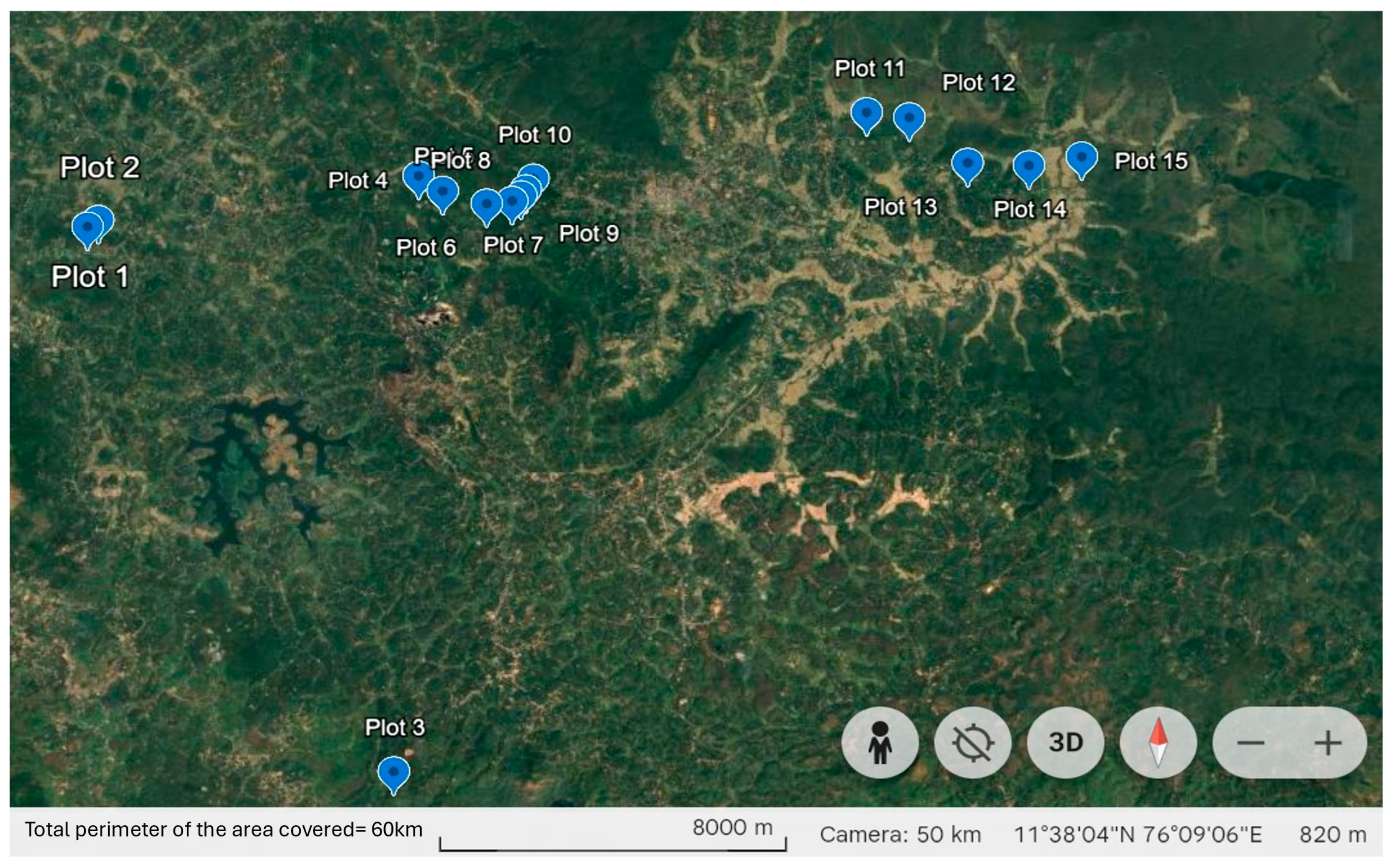

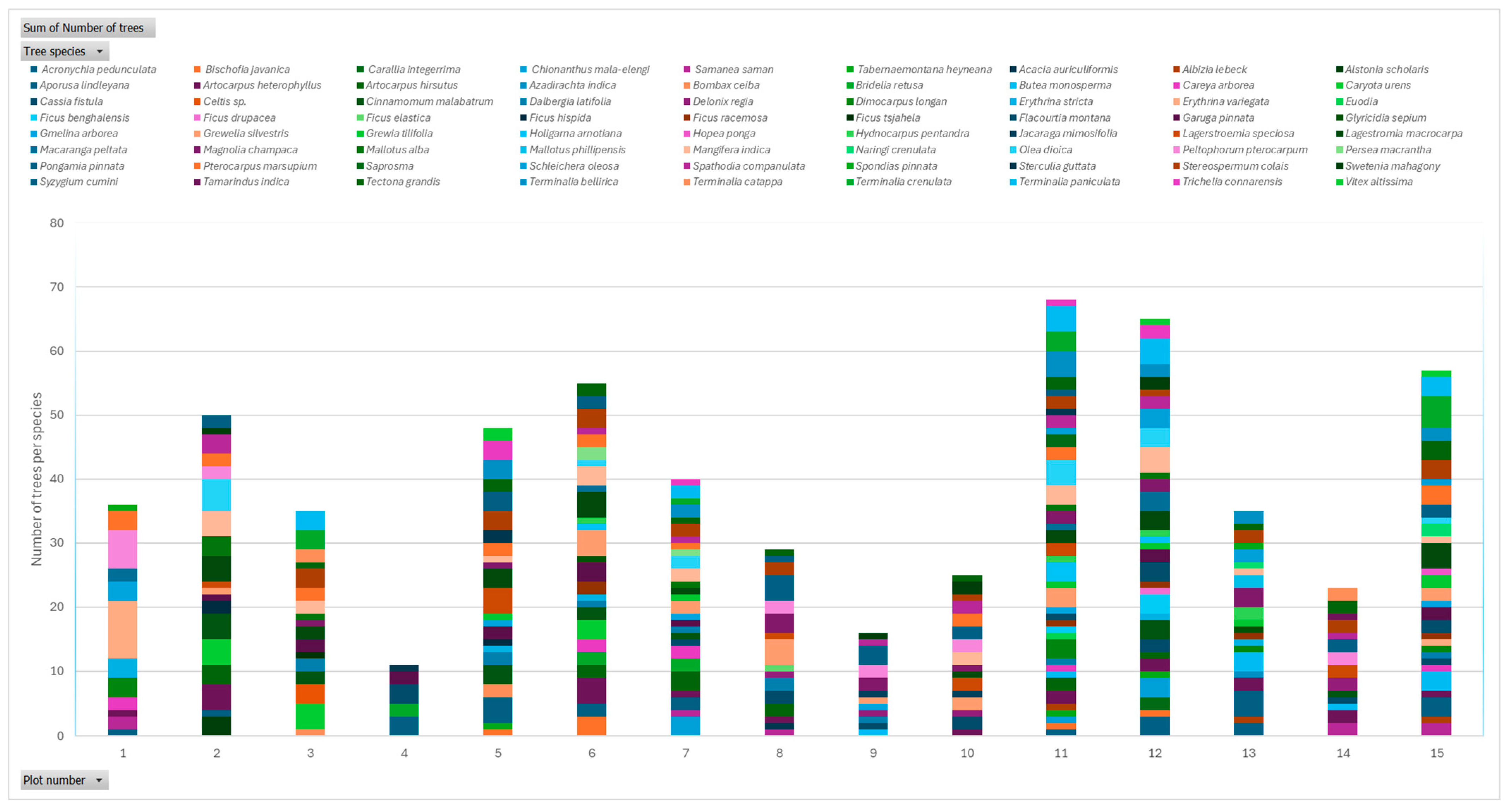
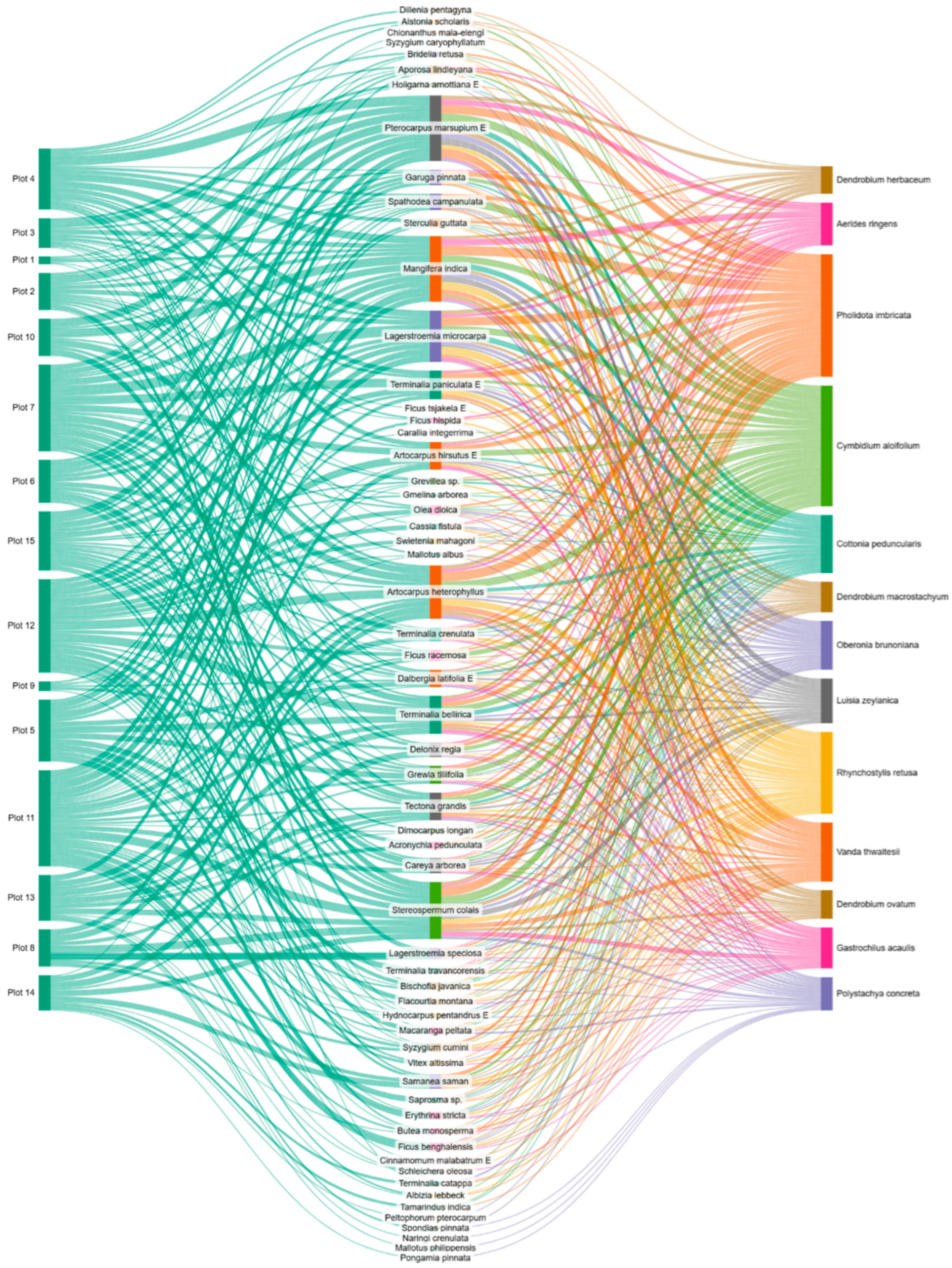


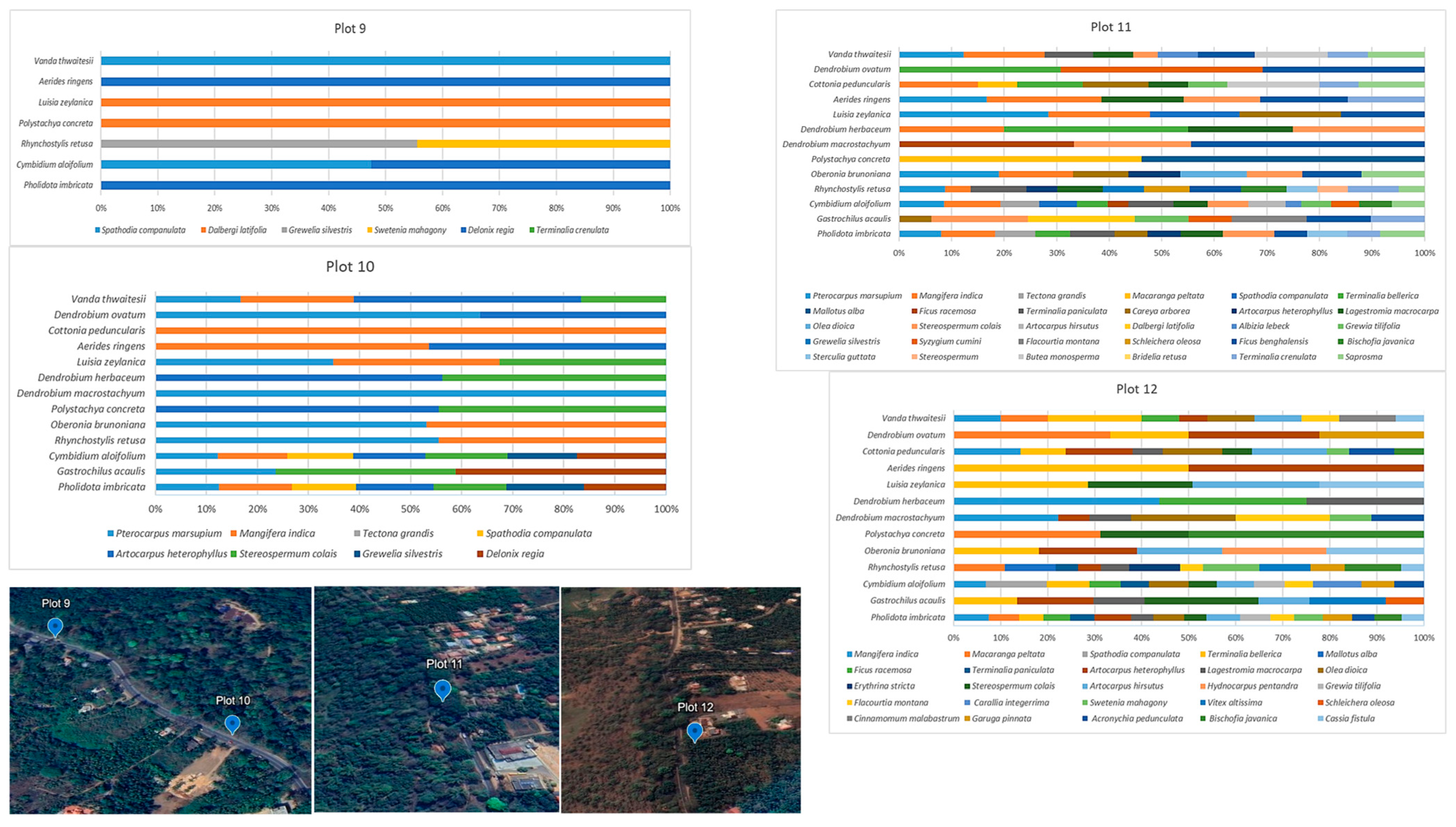
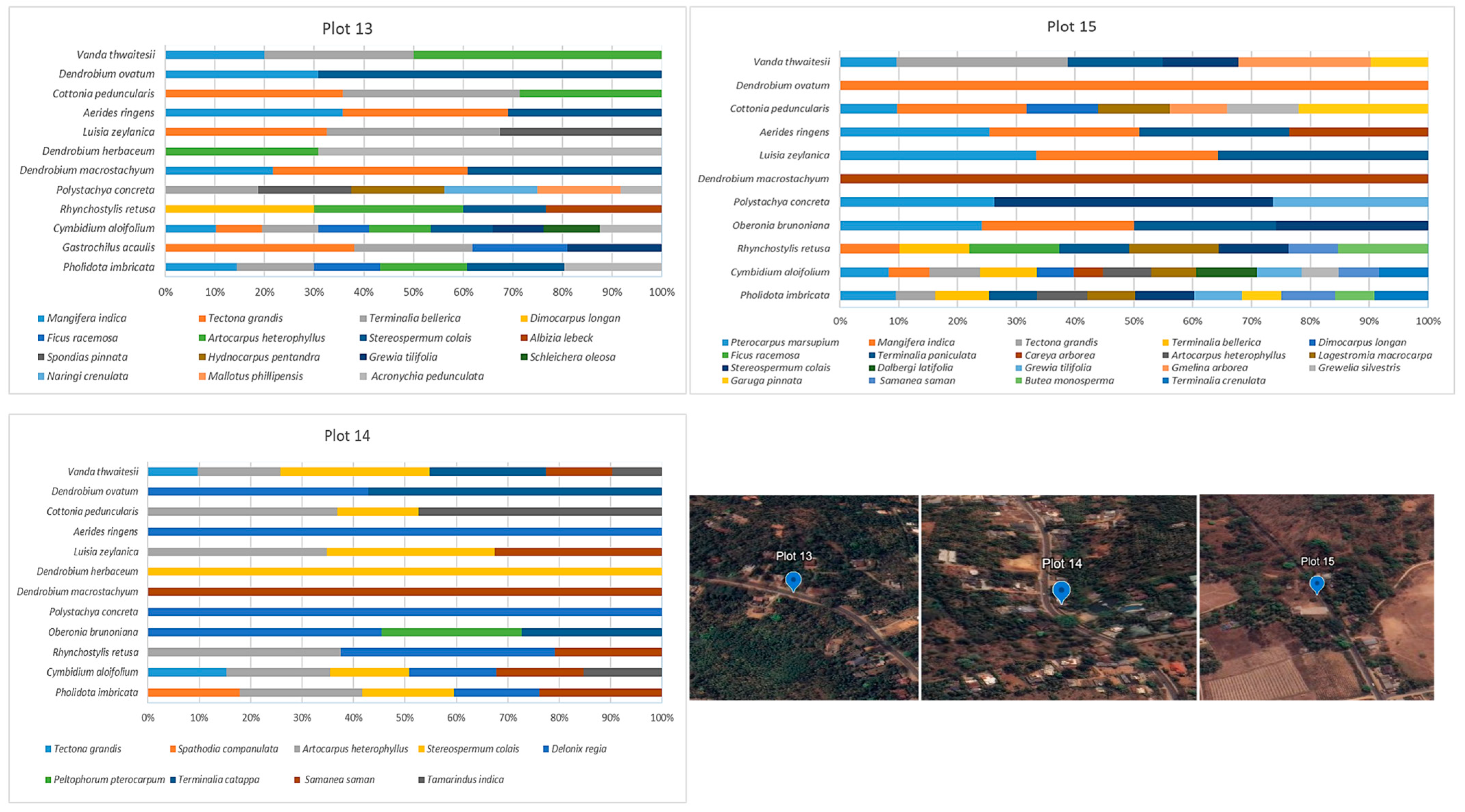
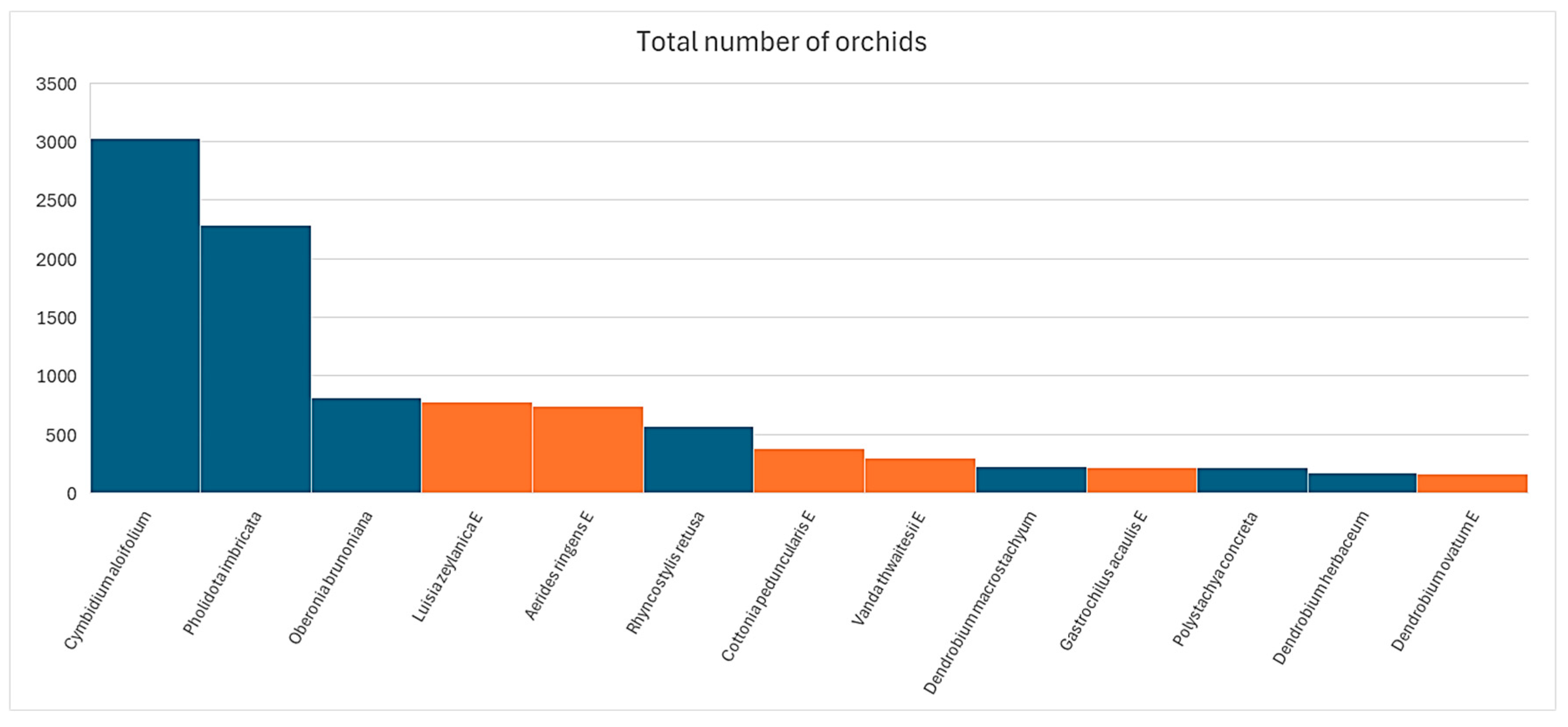
| Plot No. | Plot Details | Approximate Percent Fragmentation |
|---|---|---|
| Plot 1 | The plot is close to a paddy field, with the roadside hosting both native and deciduous trees planted as part of social forestry. | 92 |
| Plot 2 | The original forest landscape is partially replaced with introduced social forestry, with many of the original forest trees still existing. | 7 |
| Plot 3 | The original forest landscape. | 4 |
| Plot 4 | The original forest landscape is partially replaced with social forestry trees, with some original forest trees still existing. | 7 |
| Plot 5 | Mixture of native and social forestry origin trees. | 9 |
| Plot 6 | Roadside and fallowed coffee plantation with mixture of native and plantation trees. | 11 |
| Plot 7 | Close to the urban area with small number of native trees. | 15 |
| Plot 8 | Within the urban area which is dry with abundance of exotic trees orchid species. | 19 |
| Plot 9 | Within the urban areas, with sampled areas which are dry. | 94 |
| Plot 10 | Urban area and dry area abundant with social forestry trees. | 24 |
| Plot 11 | Close to the Wayanad wildlife sanctuary with a high proportion of native trees. | 7 |
| Plot 12 | Social forestry trees interspersed with native forest trees. | 10 |
| Plot 13 | Sampled areas host more social forestry taxa than native trees. | 16 |
| Plot 14 | Mix of domesticated trees and social forestry trees with few native trees. | 20 |
| Plot 15 | Mix of social forestry and domesticated trees with coffee plantations nearby. | 14 |
Disclaimer/Publisher’s Note: The statements, opinions and data contained in all publications are solely those of the individual author(s) and contributor(s) and not of MDPI and/or the editor(s). MDPI and/or the editor(s) disclaim responsibility for any injury to people or property resulting from any ideas, methods, instructions or products referred to in the content. |
© 2025 by the authors. Licensee MDPI, Basel, Switzerland. This article is an open access article distributed under the terms and conditions of the Creative Commons Attribution (CC BY) license (https://creativecommons.org/licenses/by/4.0/).
Share and Cite
Sarasan, V.; Venugopal, M.; Narayanan, R.M.K.; Nair, S.S.; Sukumaran, P.N. Distribution and Abundance of Native Orchids on Roadside Trees in a Global Biodiversity Hotspot. Diversity 2025, 17, 580. https://doi.org/10.3390/d17080580
Sarasan V, Venugopal M, Narayanan RMK, Nair SS, Sukumaran PN. Distribution and Abundance of Native Orchids on Roadside Trees in a Global Biodiversity Hotspot. Diversity. 2025; 17(8):580. https://doi.org/10.3390/d17080580
Chicago/Turabian StyleSarasan, Viswambharan, Mithun Venugopal, Ratheesh M. K. Narayanan, Sidharth S. Nair, and Pradeep N. Sukumaran. 2025. "Distribution and Abundance of Native Orchids on Roadside Trees in a Global Biodiversity Hotspot" Diversity 17, no. 8: 580. https://doi.org/10.3390/d17080580
APA StyleSarasan, V., Venugopal, M., Narayanan, R. M. K., Nair, S. S., & Sukumaran, P. N. (2025). Distribution and Abundance of Native Orchids on Roadside Trees in a Global Biodiversity Hotspot. Diversity, 17(8), 580. https://doi.org/10.3390/d17080580









